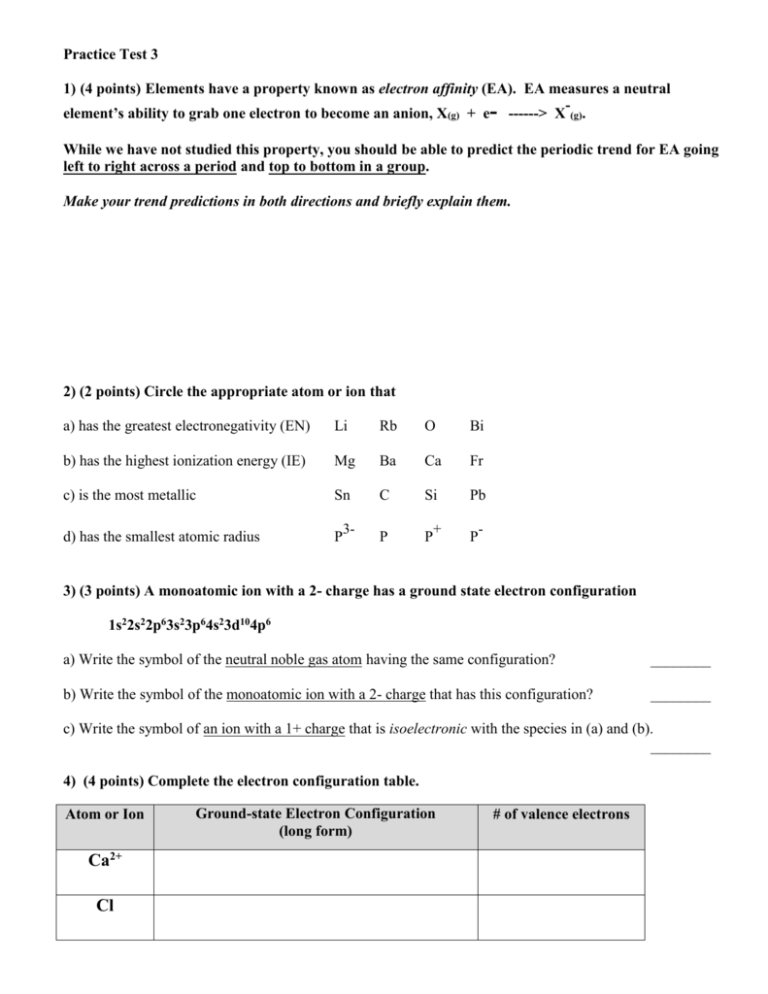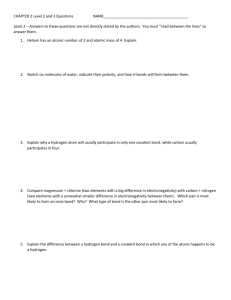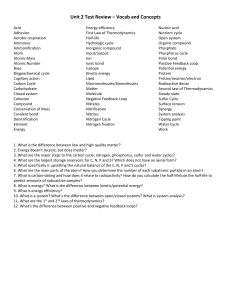Practice Test 3 - Seattle Central College
advertisement

Practice Test 3 1) (4 points) Elements have a property known as electron affinity (EA). EA measures a neutral element’s ability to grab one electron to become an anion, X(g) + e- ------> X (g). While we have not studied this property, you should be able to predict the periodic trend for EA going left to right across a period and top to bottom in a group. Make your trend predictions in both directions and briefly explain them. 2) (2 points) Circle the appropriate atom or ion that a) has the greatest electronegativity (EN) Li Rb O Bi b) has the highest ionization energy (IE) Mg Ba Ca Fr c) is the most metallic Sn C Si Pb d) has the smallest atomic radius P P P 3- + P - 3) (3 points) A monoatomic ion with a 2- charge has a ground state electron configuration 1s22s22p63s23p64s23d104p6 a) Write the symbol of the neutral noble gas atom having the same configuration? ________ b) Write the symbol of the monoatomic ion with a 2- charge that has this configuration? ________ c) Write the symbol of an ion with a 1+ charge that is isoelectronic with the species in (a) and (b). ________ 4) (4 points) Complete the electron configuration table. Atom or Ion Ca2+ Cl Ground-state Electron Configuration (long form) # of valence electrons 5) (4 points) Element 118 (ununoctium) can be produced by colliding californium-249 and calcium-48. The actual isotope of element 118 is ununoctium-294. This isotope decays in 1.29 msec. a) How many neutrons are in an atom of ununoctium-294. __________ b) Write the short form ground state electron configuration for element 118 c) In what chemical family would element 118 belong? __________ d) State one possible physical property and one possible chemical property for element 118. ________ ________ 6) (5 points) Magnesium reacts with nitrogen to produce magnesium nitride. a) What type of compound is magnesium nitride? __________ b) Write the Lewis Dot symbols for a magnesium atom and a nitrogen atom. __________ __________ c) Clearly indicate that each element achieves an octet in the formation of magnesium nitride. d) Write the formula for magnesium nitride. __________ 7) (5 points) Phosphorus and iodine react to produce phosphorus triiodide. The electronegativities of P and I are 2.1 and 2.5, respectively. a) What type of compound is phosphorus triiodide? __________ b) Write the Lewis Dot symbols for a phosphorus atom and an iodine atom. __________ __________ c) Clearly indicate that each element achieves an octet in the formation of phosphorus triiodide. d) Write the formula for phosphorus triiodide. __________ e) Is the bond between phosphorus and iodine ionic, polar covalent, or non-polar covalent? __________ Use the given electronegativities to support your answer. 38) (3 points) Draw the Lewis Dot structure for PO4 . Show all lone pairs and bond pairs. Show bond dipole moments on each bond. 9) (2 points) TRUE or FALSE a) A covalent bond likely forms when Se and Sr react. ______ b) C2- is isoelectronic with O. ______ + c) The ionization energy of Mg is less than that of Mg. ______ d) A bond can be defined as a net attractive force between particles. ______ e) OF2 and SeBr2 have similar Lewis Dot structures ______ f) Non-metals conduct electricity. ______ g) The quantum mechanical model of the atom includes all of the Bohr model. ______ h) The bond between As and N is polar covalent. ______ Extra Credit (4 points) Why can’t a metallic bond be described as purely ionic or purely covalent? Your answer must include a discussion of the octet rule and the physical properties of metallic, ionic, and covalent compounds.








